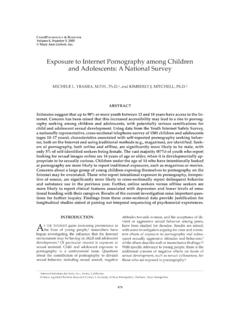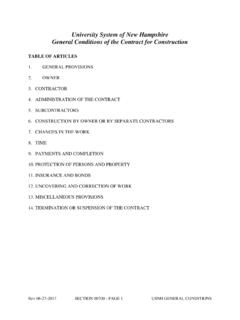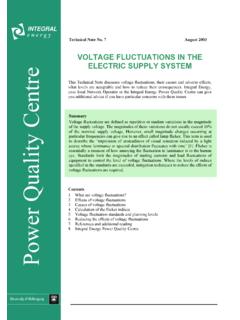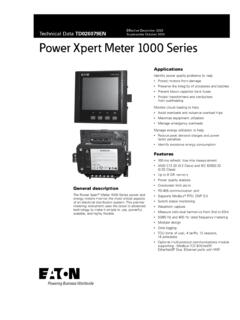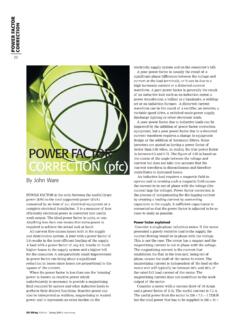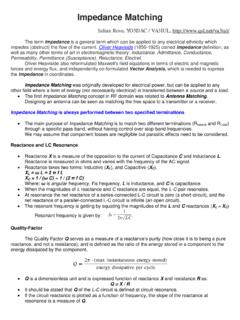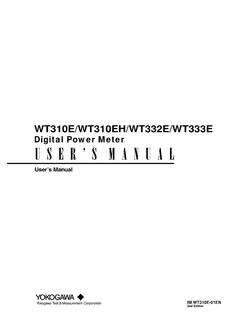Transcription of Impedance Calculations - University of New Hampshire
1 11 Revisiting a T-Line With Any Termination 00000000000000000( )2 cos2 sin2 sin2 costantanj zj zLj zj zLj zj zj zj zLLj zj zLLLj zj zLLLLLZZ eeeeZZZ zZZeeZZeeZZZZ eZZ eZz ZjzZZZZ eZZ eZjz ZzZjZzZZjZz In the general case, where a transmission line is terminated inZL,the Impedance along the line is given by:Note:Z(z)=Z0ifZL=Z0 The above equation shows how the input Impedance to anunmatched transmission line changes with electrical length, the electrical length changes with frequency, the inputimpedance to an unmatched line will be frequency CalculationsBecause the formula for Impedance is a bit cumbersome and notintuitive, design Calculations and measurements are often madegraphically using a Smith Chart. The Smith Chart works withnormalized Impedance and admittance, where normalization ismade with respect to the characteristic Impedance of thetransmission example, the normalized Impedance for a loadZL= 73 + j42 on a50 transmission line isZLN= + plotting the normalized load Impedance on a Smith Chart, theinput Impedance as a function of line length can be Smith Chart also provides the value of the reflectioncoefficient, power delivered to load, as well as the voltage standingwave ratio (VSWR)Distance measurements are given in terms of atCenter at1+j0(matched)(matched)
2 Re{ Z or Y }Re{ Z or Y }Im { Z or Y }Im { Z or Y }The Smith ChartThe Smith ChartTo findTo findZalong the line for a particularalong the line for a particularZL, find, findZL/Z0on the charton the chartand draw a circle, centered atand draw a circle, centered at1+j0through that point. Points onthrough that point. Points onthat circle represent Impedance on the line corresponding tothat circle represent Impedance on the line corresponding todistance which is read from the scale wavelengths toward thedistance which is read from the scale wavelengths toward thegenerator .generator .Blank Smith ChartBlank Smith Chart33 Bottom Scale of Smith ChartBottom Scale of Smith ChartNetwork Analyzer Smith Chart DisplayNetwork Analyzer Smith Chart Display44 Another Smith Chart Type DisplayAnother Smith Chart Type DisplaySmith Chart ExampleSmith Chart ExampleA halfA half--wave dipole antenna (wave dipole antenna (Z = 73 + j42 ) is connected to a) is connected to a50 transmission line.
3 How long must that line be before thetransmission line. How long must that line be before thereal part of the input Impedance isreal part of the input Impedance is50 ??Step 1:Step 1:plot the normalized Impedance (plot the normalized Impedance ( + ) on the Chart) on the ChartStep 2:Step 2:Draw a circle through that point, with the center of theDraw a circle through that point, with the center of thecircle atcircle at1 + j0ZL= 73 + j42Z0= 50 Re{ Zin} = 50 Step 3:Step 3:Move along the circle you drew, towards the generator,Move along the circle you drew, towards the generator,until you intercept theuntil you intercept theRe{ ZN}=1circle is intercepted. Thecircle is intercepted. Thedistance moved on the circle to get to that intercept, read from thedistance moved on the circle to get to that intercept, read from the wavelengths toward generator scale, represents the length of the wavelengths toward generator scale, represents the length of thetransmission linetransmission line.
4 55 Smith Chart ExampleSmith Chart + + withIntercept withRe{ ZN}= Smith Chart ExampleSmith Chart ExampleThe distance moved on the scale isThe distance moved on the scale = ..This represents the length of the transmission line, whereThis represents the length of the transmission line, where isisthe wavelengththe wavelengthin the transmission linein the transmission normalized input Impedance for that transmission line isThe normalized input Impedance for that transmission line isread from the Smith Chart to beread from the Smith Chart to This is read from the. This is read from thepoint where the circle you drew intersects thepoint where the circle you drew intersects theRe{ ZN} = actual input Impedance to the terminated line isThe actual input Impedance to the terminated line is( )50= = ZINWhat we will be doingWhat we will be doinglater islater isto add a reactive component that willto add a reactive component that willcancel the reactive component of the input Impedance , resulting incancel the reactive component of the input Impedance , resulting inan input Impedance equal toan input Impedance equal toZ0(a perfect match).
5 We will do this(a perfect match). We will do thisusing singleusing single--stub MatchingStub MatchingAs shown previously, the input Impedance (admittance) of aAs shown previously, the input Impedance (admittance) of ashorted transmission line (a stub ) is purely reactive. By placingshorted transmission line (a stub ) is purely reactive. By placinga stub in parallel with another transmission line, the reactivea stub in parallel with another transmission line, the reactivecomponent can be cancelled, leaving a purecomponent can be cancelled, leaving a pure--real inputreal inputimpedance. This can be used to achieve a perfect This can be used to achieve a perfect 50 Zin= 50 ZZLLdTo do this, we need to chooseTo do this, we need to choose so that the real part of the inputso that the real part of the inputadmittance is equal to the characteristic admittance, and thenadmittance is equal to the characteristic admittance, and thenchoosechoosedso that the reactive components cancel.
6 This can all beso that the reactive components cancel. This can all bedone on the smith on the smith Matching ExampleStub Matching ExampleStep 1:Step 1:Plot the normalized load Impedance (Plot the normalized load Impedance ( + ), and), anddraw a circle through that point, centered atdraw a circle through that point, centered at1 + j0. Get the. Get thenormalized load admittance by drawing a line fromnormalized load admittance by drawing a line fromZLNthroughthrough1+j0until you intersect the circle you drew on the other you intersect the circle you drew on the other the chart, you get a normalized load admittance ofFrom the chart, you get a normalized load admittance andanddthat will match our halfthat will match our half--wave dipole antennawave dipole antenna((ZL=73+j42 ) to a) to a50 transmission :Note:Since we are going to add the stub in parallel with theSince we are going to add the stub in parallel with thetransmission line, it will be easier to work with admittance rathertransmission line, it will be easier to work with admittance ratherthan 2:Step 2.
7 Move towards the generator (clockwise) on the circle youMove towards the generator (clockwise) on the circle youdrew until you intersect thedrew until you intersect theRe{ YN}=1circle. The distance youcircle. The distance youmoved to get to that intersection corresponds to the distancemoved to get to that intersection corresponds to the distance (( = -( ) = ). From the Smith Chart, the). From the Smith Chart, thenormalized input admittance at this point isnormalized input admittance at this point is1+ Matching ExampleStub Matching ExampleStep 3:Step 3:In this step, we are looking for the length,In this step, we are looking for the length,d,of a shortedof a shortedstub that will have an input admittance ofstub that will have an input admittance The load. The loadadmittance of a short is infinity (admittance of a short is infinity (YL= )), so that is where we will, so that is where we willbegin on the Smith Chart.
8 We will move towards the generatorbegin on the Smith Chart. We will move towards the generatorfrom the pointfrom the pointYL= until we intercept theuntil we intercept theIm{ YN= }line. Atline. Atthis point, the input admittance to the shorted stub isthis point, the input admittance to the shorted stub The. Thedistance traveled to get to that point (distance traveled to get to that point ( = ) is) 50 Zin= 50 ZZLLdUsing these values ofUsing these values of andanddwill result in a perfect match atwill result in a perfect match atthe frequency for which it was designed. That match willthe frequency for which it was designed. That match willdegrade as the frequency as the frequency + + Intersection withIntersection withRe {YN}=1circlecircleYN=1+ YYLNLN=0= Parameters for Example = -( )= d= = .139 Notes: going around the Smith Chart once corresponds to movinga distance of wavelengths on the transmission line the system will be matched at a single frequencyQuarter-Wave Matching TransformerUsed to convert anyrealload Impedance (ZL) to a desiredreal input Impedance (Zin).
9 ZLZ0 Zin /4 Note:we can make ourload real by placing areactance-cancellingcomponent in parallel /4represents one-half rotation around the SmithChart, the normalized input Impedance is equal to thenormalized admittance ofZL::001 NinLLZYZZZ 02001S :oLinZZLZZZZ 99 Quarter-Wave Matching Transformer(2)We can use this equation to find the characteristic Impedance (Z0)of the quarter-wave length on T-line:0inLZZ Z For example:find the characteristic Impedance of a quarter-wavelength section of T-line that would match our half-wavedipole antenna to a 50 T-line (assume that the j42 reactivecomponent has been cancelled): 050 Z Comment about stub and quarter-wave matching techniques:Since all of the T-line dimensions are in wavelengths, thematch will exist only over a narrow range of approaches need to be used to achieve broadbandmatching.
